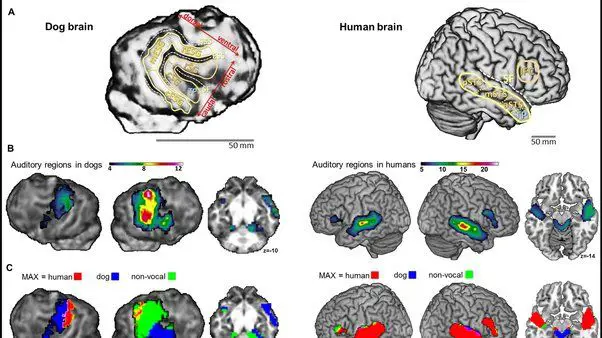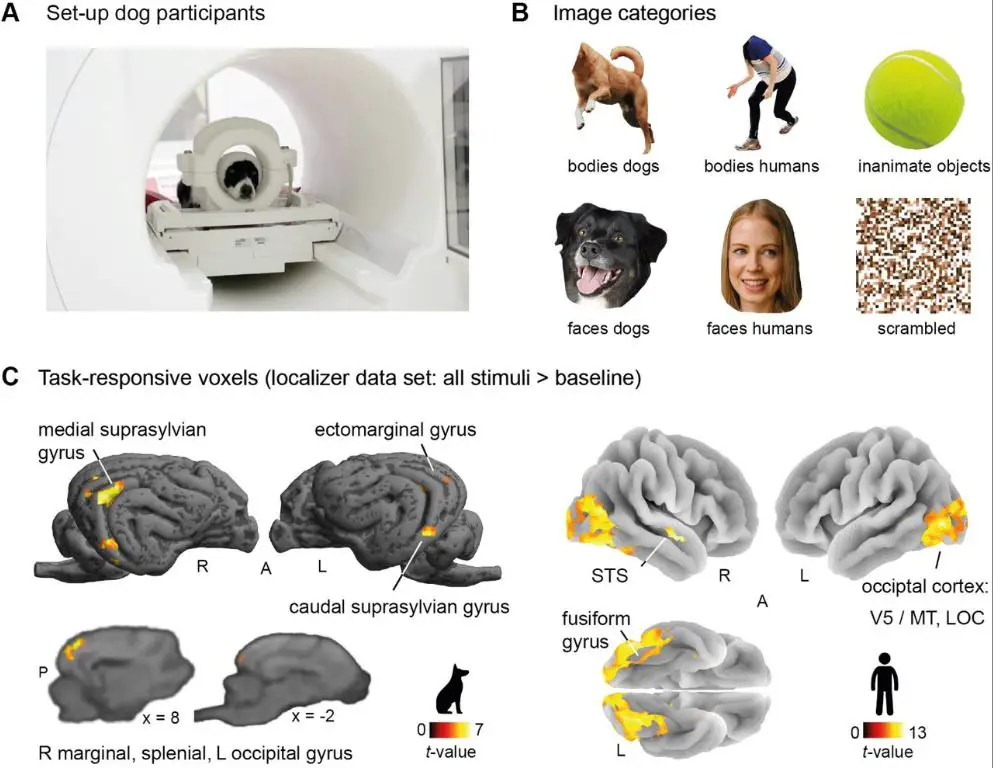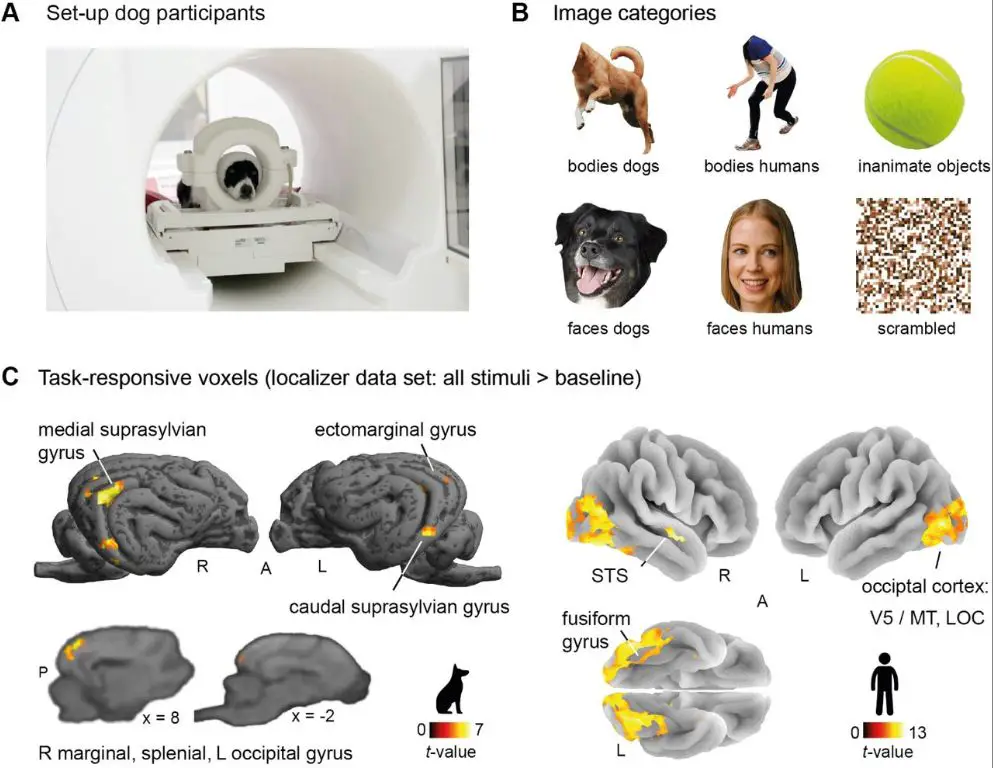Introduction
When it comes to brain anatomy, there are key differences as well as surprising similarities between humans and dogs. While a dog’s brain is much smaller and lacks some of the higher functioning areas present in the human brain, the basic structures are actually quite comparable. In terms of overall size and weight, lobe structure, cortex makeup, and number of neurons, dog brains share many characteristics with human brains despite notable variances in cognition and intelligence. By exploring brain anatomy across these two species, we can better understand how the brain’s physical form enables function.
Size and Weight

There are significant differences in the size and weight of dog and human brains. On average, the brain of a dog is about 1/10 the size of the human brain. For example, the brain of a Labrador Retriever weighs around 80 grams, whereas the human brain weighs approximately 1300-1400 grams.
When comparing brain size, it is important to consider the ratio of brain size to overall body size rather than just the absolute weight. Dogs have much smaller bodies than humans, so their brains do not need to be as large. The ratio of brain weight to body weight provides a measure called “encephalization quotient” (EQ). The average EQ for dogs is 1, versus 7 for humans.
To give a sense of scale, the brain of a Chihuahua may be just 30 grams, around the size of a large walnut. The brain of a Labrador is roughly the size of a tennis ball. Meanwhile, the human brain is about the size of a small head of cauliflower. So while dog brains are quite small, they are the right size for their bodies.
Lobes

The cerebral cortex of the dog brain is divided into four lobes just like the human brain – frontal, parietal, occipital, and temporal. However, there are some key differences in the relative size and function of these lobes between dogs and humans.
The frontal lobe in humans is much larger compared to dogs and is associated with higher cognitive functions like planning, decision making, and controlling emotions. The dog frontal lobe is smaller and devoted more to interpreting smells, sounds, and coordinating movement.
The parietal lobe handles sensory information in both humans and dogs, but the dog parietal lobe is specialized for processing smells. In humans, the parietal lobe plays a bigger role in processing touch, temperature, and pain.
The occipital lobe is the visual processing center in both species, but it tends to be smaller in dogs who rely less on vision compared to humans. In contrast, the temporal lobe is larger in dogs than humans and is crucial for auditory processing and memory formation.
Overall, the dog brain prioritizes olfactory, auditory and motor functions in the forebrain, while the back of the brain is devoted to vision. In humans, the forebrain emphasizes executive functions, language, emotion, and memory with all senses being processed in overlapping regions.
The Cerebrum
The cerebrum is the largest part of the brain and makes up the bulk of the forebrain in both dogs and humans. The cerebrum consists of two hemispheres divided into four lobes. The four lobes in both dog and human cerebrum are the frontal, temporal, parietal, and occipital lobes.
The cerebrum is responsible for high-level brain functions such as interpreting sensory impulses, thinking, reasoning, emotions, learning, speech, and fine motor skills. In both dogs and humans, the cerebrum coordinates and regulates voluntary movements. It controls functions like walking, running, sitting, and laying down. The cerebrum allows humans and dogs to be conscious, perceive emotions, store memories, and interact socially.
An important difference is that the cerebrum makes up around 80% of the human brain but only around 50% of the dog brain. The large size of the human cerebrum accounts for the higher reasoning, language, creativity, and problem solving abilities in humans compared to dogs.
In terms of location, the cerebral cortex or outermost part of the cerebrum is deeply folded and convoluted in humans. In contrast, the cortical surface of the dog cerebrum is much smoother with fewer ridges and valleys. This increased folding and gyri in humans allows for more neurons and connections.
Cerebellum
The cerebellum is located at the back of the brain right below the cerebrum. It is responsible for coordinating movement and balance in both dogs and humans.
In dogs, the cerebellum accounts for about 10% of the total brain volume. It receives sensory information from the vestibular system about balance, as well as from the spinal cord about limb position and movement. This allows it to smoothly coordinate body movements, balance, posture and gait.
In humans, the cerebellum makes up around 10% of total brain volume, similar to dogs. It gets input from the inner ear about balance and equilibrium. It also gets information from the eyes and muscles about body position and involuntary muscle movements. This allows it to coordinate voluntary motor movement, balance, posture and speech.
Damage to the cerebellum in both dogs and humans can result in loss of coordination, balance and fine motor control. Overall, the location and function of the cerebellum is very similar between dogs and humans.
Brain Stem
The brain stem is located at the base of the brain and connects the brain to the spinal cord. It relays signals between the brain and body and controls critical functions like breathing, blood pressure, and heart rate.
In both dogs and humans, the brain stem consists of the midbrain, pons, and medulla oblongata. The midbrain controls eye movements and some reflexes. The pons relays signals between the cerebrum and cerebellum. The medulla oblongata controls involuntary actions like breathing, swallowing, vomiting, and heart rate.
A key difference is that a dog’s brain stem is proportionally larger than a human’s. This allows it to control more instinctual functions. For example, a dog’s medulla oblongata has a well-developed respiratory center to support sniffing behaviors. The brain stem also enables rapid reflex reactions characteristic of dogs, like quickly turning the head at a sudden noise.
Overall, the brain stem allows seamless communication between the brain and body for both species. But the dog’s brain stem is specialized to govern involuntary processes and instinctual responses.
Cortex

The cortex is the outer layer of the brain and is responsible for higher-order functions like reasoning, language, emotion, and sensory perception. There are some key differences between the cortex in dogs and humans.
The human cortex has many folds and ridges known as gyri and sulci. These folds allow for a larger surface area and increased neurons in the limited space of the skull. The extensive folding enables complex thought and reasoning. In contrast, the dog cortex is much smoother with minimal gyri and sulci. Dogs have fewer overall folds than humans.
Additionally, the thickness of the cortex varies between dogs and humans. Human cortex is generally 2.5-4.5mm thick, while the dog cortex is typically 1.5-3mm thick. The thinner cortex in dogs results in fewer neurons and synaptic connections.
Furthermore, certain cortical areas are more pronounced in humans versus dogs based on functional needs. Humans have a large highly developed frontal cortex associated with executive functions. Dogs’ olfactory cortex is proportionally larger to facilitate their excellent sense of smell. The differences in cortical anatomy contribute to variations in capabilities between canine and human brains.
Neurons
Dogs have about 530 million cortical neurons compared to humans who have around 16 billion. However, based on ratio of neurons to brain size, dogs actually have more neurons packed into their cerebral cortex than humans do. The cerebral cortex is where information processing takes place.
Both humans and dogs have various types of neurons, including pyramidal cells, spindle neurons, mirror neurons, and more. However, the number, ratio, structure, and density of these neurons differs:
- Pyramidal cells, which conduct signals between different cortical areas, make up around 70-80% of cortical neurons in humans but only about 40-50% in dogs.
- Spindle neurons help process emotions and social cognition. Dogs have significantly fewer spindle neurons than humans.
- Mirror neurons enable mimicry and empathy. While both species have them, mirror neuron density is lower in dogs compared to humans.
Overall, dogs have fewer total neurons, especially in areas associated with higher cognition and intelligence. However, dogs excel in sensory perception thanks to higher densities of neurons in sensory regions. The structure and organization of neurons also differs between species.
Intelligence
When it comes to intelligence and cognition, humans and dogs differ quite a bit. Humans have highly advanced language skills, abstract thinking, and reasoning abilities that dogs lack. We are able to communicate with complex language, create art and music, invent tools and technology, understand complex mathematical and scientific concepts, reflect on the past and plan for the future.

Dogs, on the other hand, have very limited language skills. While they can understand words and commands, their own forms of communication are much simpler, mainly consisting of different barks, whines, and body language. Dogs also lack the ability for abstract thought and complex reasoning. Their intelligence is more focused on social cognition and reading human behavior and emotion.
However, research has shown dogs may have some more advanced mental abilities when it comes to concepts like object permanence, short-term memory, and problem solving skills. But their cognition is still limited compared to humans. Dogs also excel at tasks involving scent detection and hunting. So while a dog’s intelligence and mental abilities are impressive for an animal, human cognition is far more advanced and complex when it comes to language, reasoning, abstract thought, creativity, and planning.
Conclusion
In summary, there are some notable similarities and differences between the dog brain and the human brain. Both have a cerebrum, cerebellum, and brain stem, but the human brain is much larger and has a more developed cortex. The human brain also has specialized regions for speech and complex thought that are not found in the dog brain. Dogs do have excellent senses of smell and hearing compared to humans.
The key takeaway is that the human brain is far more complex and advanced than the dog brain. Humans have evolved higher cognitive capabilities including language, abstract thinking, imagination, and complex problem solving. However, the dog brain excels in areas like scent tracking. Understanding the differences allows us to appreciate the uniqueness of both human and canine intelligence.